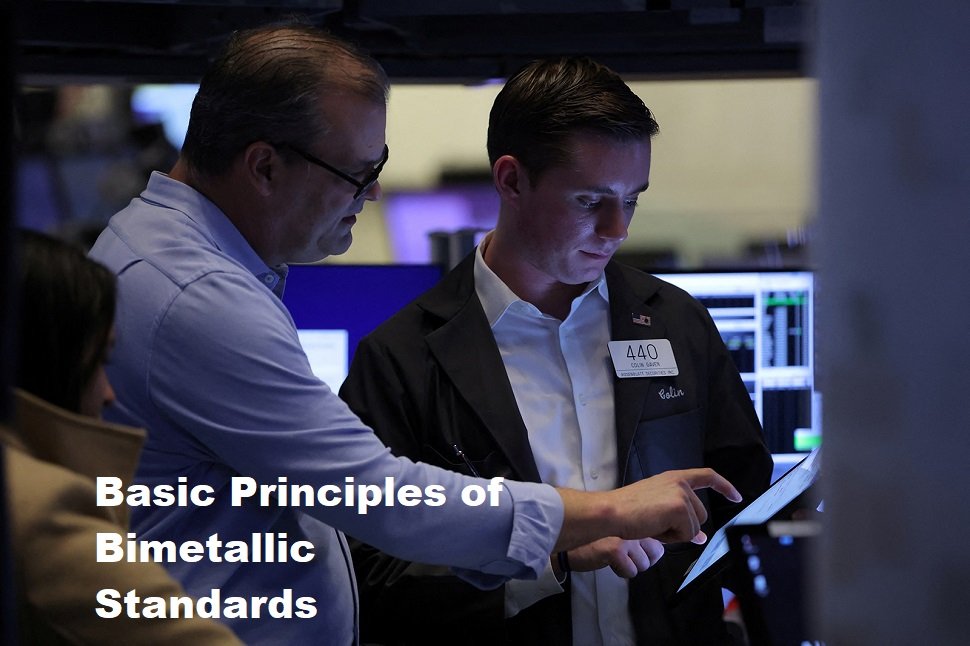A bimetallic standard is a monetary system that uses two different metals as the basis of its currency, usually gold and silver. In this system, the value of currency is measured in both gold and silver. Each unit of currency can be exchanged into a certain amount of gold or silver, depending on a fixed ratio set by the government or monetary authority. The main goal of the bimetallic standard is to create economic stability and control inflation. This system ensures that the value of the currency is maintained because it is guaranteed by the country’s gold and silver reserves. Additionally, the bimetallic standard helped maintain international trade balance by allowing exchange rates to be adjusted based on the relative prices of gold and silver. The benefits of bimetallic standard systems in the economy are associated with the price and exchange rate stability they create. Under ideal conditions, bimetallic standards can prevent extreme inflation or deflation, reduce economic volatility, and create a monetary environment conducive to investment and trade. However, critics of this system point out that the bimetallic standard is often susceptible to speculation and geopolitical instability that can cause fluctuations in gold and silver prices.
In contrast to bimetallic standards, monometallic standards only link currency values to one type of precious metal, such as gold or silver. This system is simpler to implement because it only involves one metal as a standard and has several advantages in terms of cost efficiency and ease of monitoring exchange rates. However, the disadvantage of the monometallic system is that it is prone to currency value fluctuations and is more susceptible to speculation. Overall, bimetallic and monometallic standards have fundamental differences in terms of the method of determining currency value. Bimetallic standards involve two types of precious metals to create economic stability, while monometallic standards rely on just one metal. Throughout history, this system has been the subject of debate and analysis in the search for the best solution to create economic stability and a currency value that is resistant to market fluctuations.
Basic Principles of Bimetallic Standards
The basic principles of the bimetallic standard center on the concept that two precious metals, gold and silver, function as currency in a monetary system. In this system, banknotes and coins are backed by gold and silver reserves held by the government or central bank. This creates confidence in the currency because its value is based on the amount of precious metal held. One of the important principles in the bimetallic standard is a fixed rate of exchange between gold and silver. In this system, the relative value between the two metals is determined by the government or monetary authority. This fixed exchange rate allows for stability in the economic system and facilitates international trade by reducing the risk of exchange rate fluctuations.
Although exchange rates are set by the government, supply and demand for gold and silver still influence the relative value between the two in the bimetallic standard. An imbalance between supply and demand for either metal can cause changes in the relative exchange rate between the two, even if the official exchange rate remains unchanged. This can result in speculation in the market as well as shifting funds between gold and silver. The concept of “Gresham’s Law” also applies in the bimetallic standard system. Gresham’s Law states that “bad money drives out good money.” In the context of the bimetallic standard, this law means that if one precious metal becomes more expensive or rarer than another, the more valuable metal will tend to be held in reserve and will not circulate widely. Conversely, less valuable metals will be used more often in everyday transactions. This can cause changes in the proportion of gold and silver circulating in the economy.
How Bimetallic Standards Work
The mechanism for printing gold and silver coins in a bimetallic standard system is a process that involves the use of these two precious metals as the basis of currency value. Each country that adopted this system set a fixed exchange rate between gold and silver. For example, if the ratio of gold to silver is 15:1, then this means that one ounce of gold is equal to 15 ounces of silver. Central banks were responsible for minting coins based on these exchange rates, and they also had to provide gold and silver reserves to guarantee the conversion of these coins. The process of exchanging coins between individuals and financial institutions in the bimetallic standard system involves exchanging gold and silver coins of the same nominal value. Individuals can exchange their coins for more or fewer coins depending on their needs, while financial institutions are tasked with ensuring that the number of coins circulating on the market matches their precious metal reserves. These transactions enable the flow of liquidity between individuals, companies, and the economy as a whole.
The circulation of money in a bimetallic standard-based economy depends on the amount of gold and silver in the country’s reserves. Currency values are regulated by supply and demand for these two precious metals. When the economy needs more money in circulation, the central bank will print more coins, which in turn will increase the amount of gold and silver in the country’s reserves. Conversely, if there is an excess of money in circulation, the central bank can buy back coins, which will reduce the amount of gold and silver circulating in the market. The impact of inflation and deflation in a bimetallic standard system is highly dependent on the supply and demand for gold and silver in the global market. If the supply of one of the precious metals increases significantly, for example due to the discovery of a new mine, the exchange rate will decrease, causing inflation in an economy based on bimetallic standards. On the other hand, if the supply of one of the precious metals decreases, for example due to mine closures or political obstacles in international trade, the exchange rate will increase, causing deflation. In both situations, governments and central banks will be faced with decisions about how to manage the money supply and maintain economic stability. In some cases, government intervention may be necessary to control inflation or deflation and maintain the balance of the bimetallic standard system.
History of Bimetallic Standards in the World
In the 19th century, bimetallic standards were implemented in several European countries and the United States. This system involves the use of two metals, gold and silver, as the basis of currency. Each metal has a fixed value against the national currency, and both can be used for expenditure or receipt of ownership. During the 19th century, countries such as France, Belgium, Italy, Switzerland, and the United States implemented this system as the basis for their financial systems. However, in the late 19th and early 20th centuries, many countries began to switch from bimetallic to monometallic (gold standard) standards. Factors causing this shift include the discovery of new gold mines around the world which increased the supply of gold, a decline in silver production relative to gold due to technological innovation in mining, and the preference of major powers for stability in the exchange rate of their currencies relative to gold.
Examples of countries that implemented bimetallic standards before moving to a fiat currency system include the United Kingdom, the United States, Germany and Japan. The bimetallic standard in England ended in 1816 when they officially adopted the gold standard. The United States followed suit in 1900, when they fully adopted the Gold Standard Act. Germany and Japan switched from the bimetallic standard to the gold standard in the late 19th century. Lessons to be drawn from the history of bimetallic standards for the modern economy involve the importance of stability and confidence in the monetary system. The bimetallic standard demonstrated that limited currency resources such as gold and silver could lead to exchange rate volatility and dramatic changes in economic stability. The transition to a fiat currency system allows governments to more effectively regulate and maintain exchange rate stability, but it is still important for today’s economy to maintain a level of confidence in the monetary system and maintain balance in the money supply. In the era of an interconnected global economy, it is important for countries to work together to maintain stability and confidence in their currencies and ensure inclusive and sustainable economic development.









